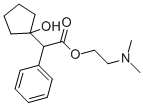CHEMICAL AND PHYSICAL PROPERTIES
| Physical Description | Solid |
|---|---|
| Melting Point | 134-136 |
| Solubility | 1.50e+00 g/L |
| LogP | 2.4 |
| Kovats Retention Index | 2010 2014 2020 |
SAFETY INFORMATION
| Signal word | Warning |
|---|---|
| Pictogram(s) |
 Exclamation Mark Irritant GHS07 |
| GHS Hazard Statements |
H302:Acute toxicity,oral |
| Precautionary Statement Codes |
P280:Wear protective gloves/protective clothing/eye protection/face protection. P305+P351+P338:IF IN EYES: Rinse cautiously with water for several minutes. Remove contact lenses, if present and easy to do. Continuerinsing. |
COMPUTED DESCRIPTORS
| Molecular Weight | 291.4 g/mol |
|---|---|
| XLogP3 | 2.7 |
| Hydrogen Bond Donor Count | 1 |
| Hydrogen Bond Acceptor Count | 4 |
| Rotatable Bond Count | 7 |
| Exact Mass | 291.18344366 g/mol |
| Monoisotopic Mass | 291.18344366 g/mol |
| Topological Polar Surface Area | 49.8 Ų |
| Heavy Atom Count | 21 |
| Formal Charge | 0 |
| Complexity | 331 |
| Isotope Atom Count | 0 |
| Defined Atom Stereocenter Count | 0 |
| Undefined Atom Stereocenter Count | 1 |
| Defined Bond Stereocenter Count | 0 |
| Undefined Bond Stereocenter Count | 0 |
| Covalently-Bonded Unit Count | 1 |
| Compound Is Canonicalized | Yes |
PRODUCT INTRODUCTION
description
Cyclopentolate is a carboxylic ester resulting from the formal condensation of (1-hydroxycyclopentyl)(phenyl)acetic acid with N,N-dimethylethanolamine. A tertiary amine antimuscarinic with actions similar to atropine, it is used as its hydrochloride salt to produce mydriasis (excessive dilation of the pupil) and cycloplegia (paralysis of the ciliary muscle of the eye) for opthalmic diagnostic procedures. It acts more quickly than atropine and has a shorter duration of action. It has a role as a mydriatic agent, a parasympatholytic, a muscarinic antagonist and a diagnostic agent. It is a carboxylic ester, a tertiary amino compound and a tertiary alcohol. It is functionally related to a (1-hydroxycyclopentyl)phenylacetic acid and a N,N-dimethylethanolamine.

